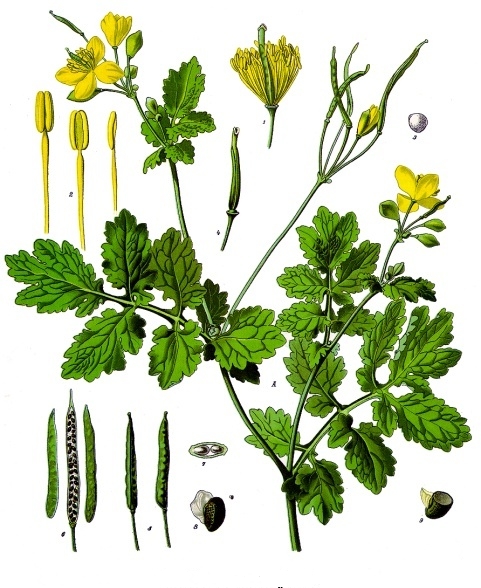 Greater Celandine
Greater Celandine
Common name
celandine?
ID
HD0032
Scientific name of the plant
Chelidonium majus L.
Anatomical part for use
above-ground part
Human use
Gastrointestinal disorders
Summary
Chelidonium majus, the greater celandine, is a perennial herbaceous flowering plant in the poppy family Papaveraceae. One of two species in the genus Chelidonium, it is native to Europe and western Asia and introduced widely in North America.
The plant known as lesser celandine (Ficaria verna) is not closely related, as it belongs to the buttercup family Ranunculaceae. (Source: Wiki)
Evidence Level
Level 4 (Individual reports repeated observed over 5 years among different countries)
Hepatotoxicity reports in literature
- Acute hepatitis induced by greater celandine (Chelidonium majus) : (Source)
- [Acute hepatitis after use of a herbal preparation with greater celandine (Chelidonium majus)] : (Source)
- Acute hepatitis induced by Greater Celandine (Chelidonium majus) : (Source)
- Chelidonium majus: a rare reason for severe hepatotoxic reaction : (Source)
- [Severe drug hepatitis caused by Chelidonium] : (Source)
- Hepatitis from Greater celandine (Chelidonium majus L.): review of literature and report of a new case : (Source)
- [Hemolytic anemia induced by Chelidonium majus. Clinical case] : (Source)
Hepatotoxicity Description
Over a dozen publications, largely from Europe, have described clinically apparent acute liver injury attributable to greater celandine (Chelidonium majus). Liver injury typically arises after 1 to 6 months, with jaundice and moderate to marked elevations in serum aminotransferase levels. The pattern of injury is usually hepatocellular and the clinical presentation and liver histology resemble acute viral hepatitis. Immunoallergic features are uncommon, but autoantibodies may be present in low to moderate levels in many cases. The clinical syndrome, however, rarely resembles autoimmune hepatitis and usually resolves rapidly once the botanical is discontinued and without need of corticosteroid therapy. (Source: LiverTox)

Common name
celandine?
ID
HD0032
Scientific name of the plant
Chelidonium majus L.
Anatomical part for use
above-ground part
Human use
Gastrointestinal disorders
Summary
Chelidonium majus, the greater celandine, is a perennial herbaceous flowering plant in the poppy family Papaveraceae. One of two species in the genus Chelidonium, it is native to Europe and western Asia and introduced widely in North America. The plant known as lesser celandine (Ficaria verna) is not closely related, as it belongs to the buttercup family Ranunculaceae. (Source: Wiki)
Evidence Level
Level 4 (Individual reports repeated observed over 5 years among different countries)
Hepatotoxicity reports in literature
- Acute hepatitis induced by greater celandine (Chelidonium majus) : (Source)
- [Acute hepatitis after use of a herbal preparation with greater celandine (Chelidonium majus)] : (Source)
- Acute hepatitis induced by Greater Celandine (Chelidonium majus) : (Source)
- Chelidonium majus: a rare reason for severe hepatotoxic reaction : (Source)
- [Severe drug hepatitis caused by Chelidonium] : (Source)
- Hepatitis from Greater celandine (Chelidonium majus L.): review of literature and report of a new case : (Source)
- [Hemolytic anemia induced by Chelidonium majus. Clinical case] : (Source)
Hepatotoxicity Description
Over a dozen publications, largely from Europe, have described clinically apparent acute liver injury attributable to greater celandine (Chelidonium majus). Liver injury typically arises after 1 to 6 months, with jaundice and moderate to marked elevations in serum aminotransferase levels. The pattern of injury is usually hepatocellular and the clinical presentation and liver histology resemble acute viral hepatitis. Immunoallergic features are uncommon, but autoantibodies may be present in low to moderate levels in many cases. The clinical syndrome, however, rarely resembles autoimmune hepatitis and usually resolves rapidly once the botanical is discontinued and without need of corticosteroid therapy. (Source: LiverTox)